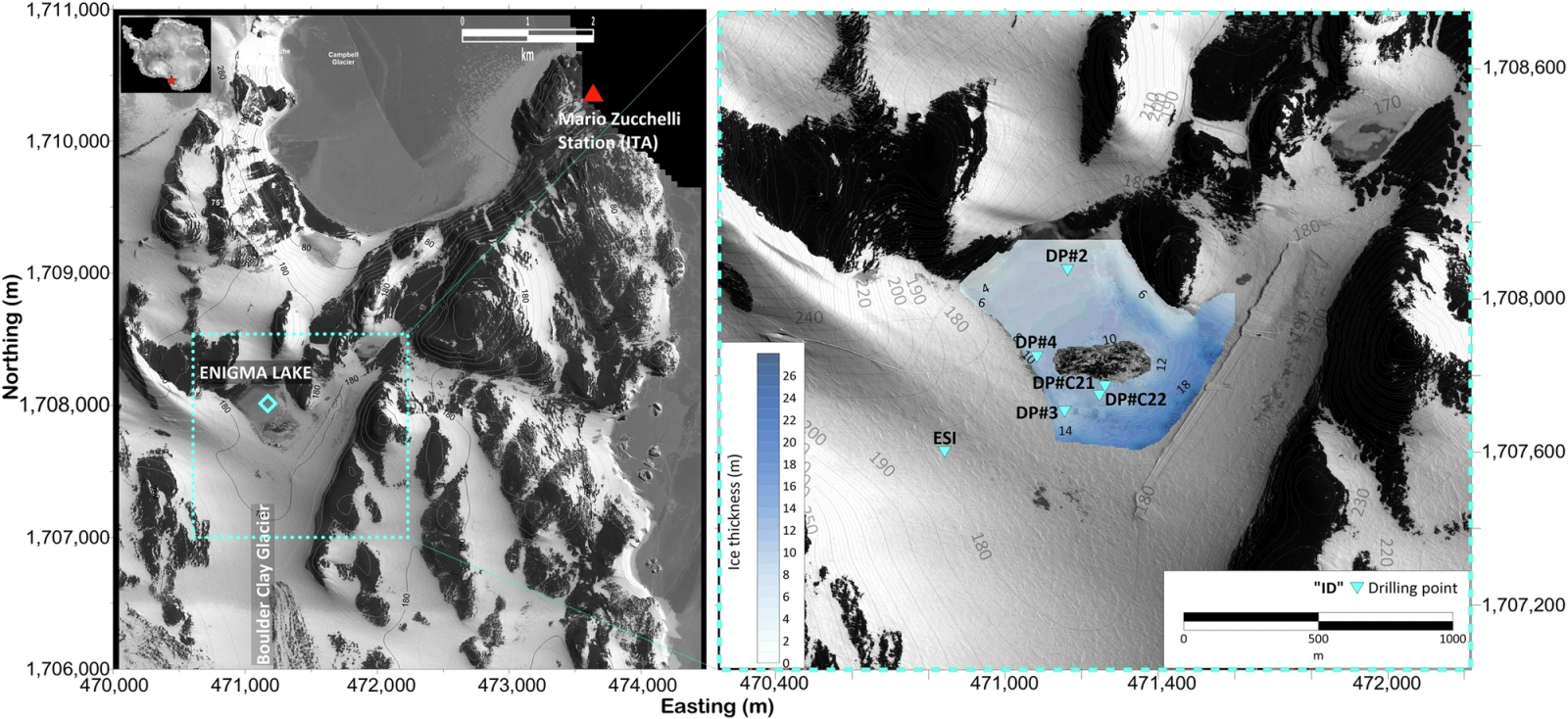Discovery of a strange form of life under Antarctic ice ❄️
Published by Cédric,
Author of the article: Cédric DEPOND
Source: Nature Communications Earth & Environment
Other Languages: FR, DE, ES, PT
Author of the article: Cédric DEPOND
Source: Nature Communications Earth & Environment
Other Languages: FR, DE, ES, PT
Follow us on Google News (click on ☆)
For a long time, researchers believed this lake was completely frozen. However, after several years of study, they discovered that beneath the frozen layer, an ecosystem thrives. An international team demonstrated that the water under the ice is actually liquid, at depths reaching up to 39 feet (12 meters).

Ice thickness interpolated by kriging (linear variogram). Base map composed of a GeoEye-1 mosaic image (data from the European Space Agency).
Coordinates projected in UTM58S (WGS84).
Lake Enigma is located between two glaciers, in an extreme environment where average temperatures are -14°C (6.8°F), with a minimum of -40.7°C (-41.3°F). Ground-penetrating radar revealed a body of water persisting beneath the ice surface. This discovery challenges our understanding of the conditions necessary for life in such extreme environments.
Drillings carried out in 2019 and 2020 allowed researchers to extract water samples, revealing the presence of microorganisms. These bacteria belong to little-studied families such as Actinomycetota and Pseudomonadota. The researchers even found extremely small bacteria, Patescibacteria, which are part of a group of simple microorganisms known for their activity, reduced genome, and tiny cell size.
The discovery of such an ecosystem in a lake frozen for millions of years raises many questions. Scientists suggest that this lake once hosted abundant life before it became covered in ice. Today, only a few microorganisms have survived these changes, giving rise to the forms of life observed there now.
Lake Enigma is particularly intriguing because, unlike other lakes in Antarctica, it appears to have a hidden water source that might explain its persistence. Some researchers believe the Amorphous Glacier could be responsible for providing water, but this theory has yet to be confirmed.

A. Submarine survey at drilling point DP#2 (depth 30.5 ft/9.3 m).
B. Complementary view at drilling point DP#2 (depth 30.5 ft/9.3 m).
C. Submarine survey at drilling point DP#4 (depth 73.8 ft/22.5 m).
D. Complementary view at drilling point DP#4 (depth 73.8 ft/22.5 m).
E. Submarine survey at drilling point DP#C22 (sampling depth 72.2 ft/22.0 m).
F. Complementary view at drilling point DP#C22 (sampling depth 72.2 ft/22.0 m).
G. Supraglacial meltwater influx from the Amorphous Glacier to the surface of Lake Enigma observed on January 3, 2020.
H. Visual evidence of the supraglacial meltwater influx during the XXXV Italian Expedition to Antarctica.
The study also revealed a stable chemical composition of the water, raising questions about how the water has remained intact despite its isolation. Researchers continue to investigate this region to better understand how such an ecosystem can endure in such a hostile environment.
Lake Enigma could provide valuable insights into the evolution of life on Earth and, perhaps, on other planets with extreme conditions. By studying this small subglacial world, scientists hope to better understand the limits of life and its adaptability.
Discoveries about this lake also serve as a reminder that life can persist in unexpected places. This opens the door to new research on extremophilic microorganisms and their ability to survive in increasingly inhospitable environments.
What are Patescibacteria?
Patescibacteria are a group of microorganisms belonging to a very peculiar bacterial superphylum. Their name derives from their extremely simple cellular structure and microscopic size.
These bacteria are characterized by their reduced genome, which limits their biological functions. They often need to interact with other organisms to survive, adopting symbiotic or parasitic lifestyles.
They are found in extreme environments, such as Antarctica's glacial lakes. Their ability to thrive under such conditions makes them a subject of study for understanding the limits of life on Earth.
The discovery of Patescibacteria in Lake Enigma highlights how resilient these bacteria are, while underscoring the importance of their role in isolated aquatic ecosystems.